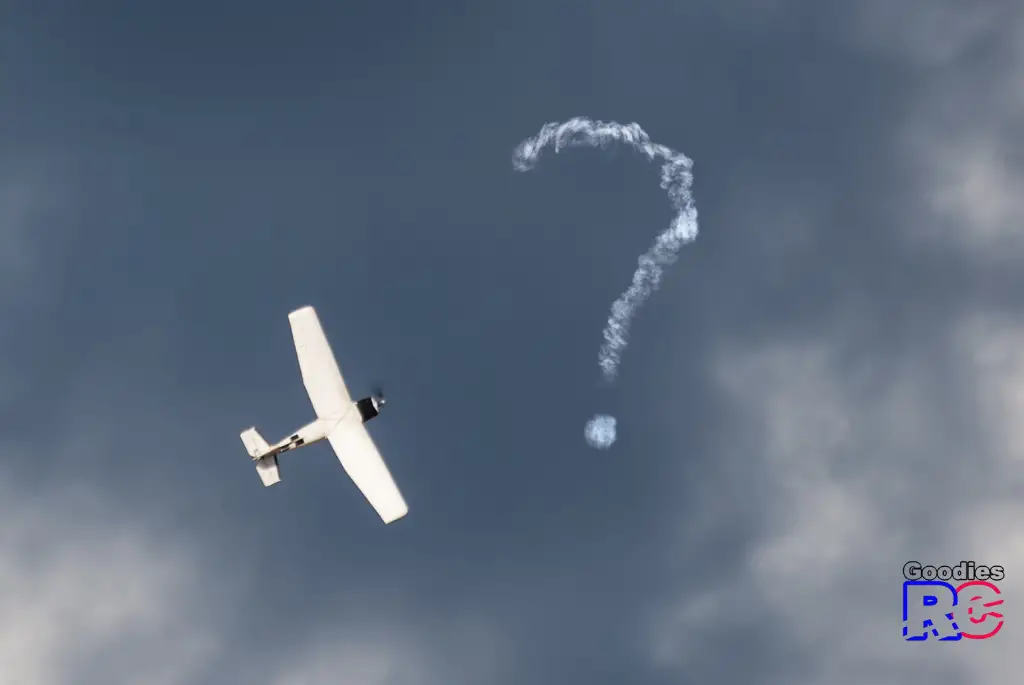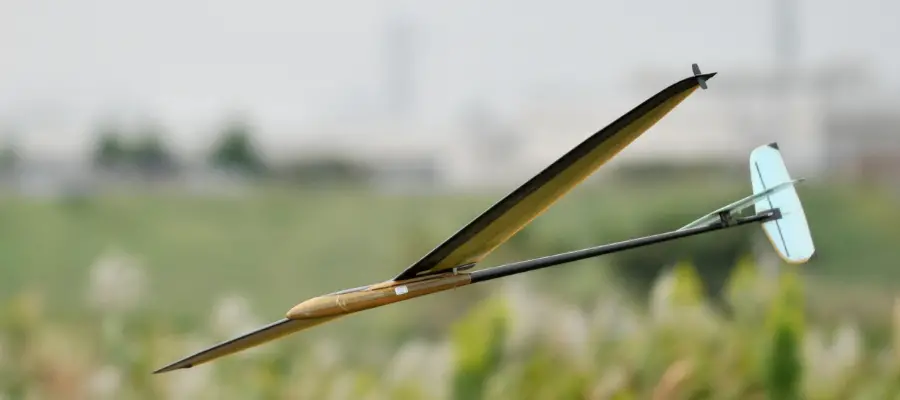Most RC aircraft enthusiasts are attracted to the hobby because it accurately mimics real-life aviation and the same physics that enables an aircraft to fly and apply equally to RC planes. Given the close relationship between RC planes and real planes, can RC planes achieve similar heights and speeds?
The RC plane world altitude record is 10,607m (34,800 ft), and the world speed record of 881km/h (548mph) was set by an unpowered slope soaring glider. Unmanned Aerial Vehicles UAVs used for research or by the military have broken the sound barrier and even reached space.
Theoretically, RC aircraft can achieve the same absolute speeds and height as their real-world counterparts. The only limitation restricting RC aircraft from achieving these heights and speeds are government regulations.

How High Can An RC Plane Go?
Whether it’s Roger Bannister breaking the four-minute mile sprint race time in 1954 or Alan Eustace jumping from 135,908 feet (41.425 km) in 2014, it is the nature of man to push boundaries continually; this applies as much to RC planes as any other activity.
In America, the Federal authorities restrict model planes to flying under a 400ft altitude. Similar rules apply in other countries, and although the values may change, the rules don’t. If RC modelers weren’t restricted in this way, the planes could reach altitudes of 5,000 feet (1.5 km).
Although the actual RC plane may have the ability to fly higher, RC pilots restrict the altitude to under 400 feet. There are several reasons.
Federal Aviation Administration (FAA) Rules Limiting RC Plane Height
In America, the FAA has published rules which apply to recreational flyers under 14 CFR Part 107. It requires an RC plane to be flown within a 400-foot (120 m) altitude limit. Irrespective of whether the plane is in controlled or uncontrolled airspace.
In the United Kingdom, the limit is 2,000 feet (600m). The rules may be different in your country so check the regulations before taking off.
See my related article: RC Plane Weight: The Ultimate Guide
RC Transmitter Range Limitations Restricting RC Plane Maximum Height
RC transmitters and receivers require a clear line of sight to send and receive the instructions.
RC planes have the most significant advantage because it is less likely that a ground structure will obstruct the signals.
There is no standard answer to the maximum RC transmitter range because different countries specify different maximum-powered transmitters. The EU only allows transmitters in the 120mw range, whereas the restriction is 200mw in America, which gives greater distance reach.
The higher the milliwatt power, the greater the range of the transmitter, and the higher you will be able to fly your RC plane without losing transmission.
Another factor is the sensitivity of the receiver in the RC plane. Some model receivers are more sensitive and can operate with a lower-powered signal from the transmitter. These units will work at longer distances.
Most RC transmitters can send signals that receivers can understand at 1.5 km (5,000 ft). This height is well above the legal limit and should never be attempted unless an exemption has been obtained from the FAA; aircraft flying through the area must be sent a NOTAM (Notice to airmen) advising them to stay clear.
The RC Plane Must Remain In Sight Limiting Maximum RC Height
Under normal circumstances, you must see the model to control it. The further away it is, the harder it is to see whether it’s approaching or moving away from you! It also becomes harder to see which way the wings are rolling and if you apply a control that you think will level the plane but instead causes the roll rate to increase, it’s going to be a bad day!
Keeping visual tabs on the RC plane limits the height to which the plane can be flown while still being able to see the orientation of the craft. New technology in the form of FPV technology has largely overcome this limitation, but the legal height laws must still be observed.
First Person View (FPV) goggles and technology include a small camera that can stream live video. A forward-facing camera is installed in the RC plane. The camera’s feed is transmitted to the goggles worn by the operator, and the result is the operator has the same views as if sitting in the pilot’s seat. This technology removes the problem of an RC plane flying out of visual range.
How Fast Can An RC Plane Go?

When car reviewers discuss the latest Ferrari, Bugatti, or Lamborghini, they don’t spend much time talking about trunk space, the sound system, or fuel economy; instead, it’s all about acceleration time, handling, and top speed. Hobbyists are just as interested in the maximum speed of their RC planes.
Depending on the type of RC plane and the propulsion system which powers it, they can achieve up to 460mph (740km/h). It’s the propulsion method and the aerodynamic features of the RC plane that impact an RC plane’s speed. The more drag created, the slower the RC plane will fly.
The Factors Which Affect An RC Planes Speed
The power produced and the drag forces created by the airframe affect an aircraft’s maximum speed, including that of an RC plane.
Check out my post: Are bigger RC planes easier to fly?
The Effects Of Drag On the Speed Of An RC Plane’s Speed
There are four forces on an RC plane.
- The thrust produced by the engine
- Drag acts opposite to the thrust
- Lift of the wings
- Gravity from mother nature
These forces are always present, and the RC pilot must keep them in balance to fly a plane. There are two types of drag – parasitic and aerodynamic. While aerodynamic drag is generally understood by most RC flyers as the shape of the aircraft, parasitic drag may not be as familiar a concept.
Read my article if your RC plane ESC is not working
Parasitic Drag On An RC Plane
This drag aspect is caused by external features added to increase the realism of the RC plane. These include wheels, antennas, guns, turrets, biplanes, two wings, etc. Scale model RC planes usually are slower than non-scale versions.
Aerodynamic Drag On An RC Plane
To understand how an RC plane shape influences speed, you need to realize that these forces don’t work in isolation, e.g.
- Wings capable of more lift create more drag. The faster an RC plane goes, the more lift produced and the higher the drag.
- Engines producing more power are heavier and create more drag.
- The slower the RC plane, the greater the effects of gravity.
The maximum speed of an RC plane with good low-speed handling is lower than planes that can’t fly as slow.
RC modelers overcome this by changing the wing’s shape during flight. They incorporate flaps on the trailing edge and slats on the leading edge of each wing. These devices create more lift and add area.
The Thrust Provided By Different Engine Types
There are three main ways to power RC planes, each offering different levels of thrust and thereby affecting the maximum speed of the aircraft.
Propellor Driven RC Planes (250mph (400km/h))
Gas engines or electrical units can power propellors. Propellors convert the rotary motion from the engine into thrust, which pulls the aircraft forward.
The downside of propellors is that the pilot must adjust the shape (pitch) of the propellor to reach higher speeds. There is a maximum achievable pitch that restricts the top speed. RC planes don’t have the facility to change the pitch; hence propellor-driven RC planes are slower.
Electric Ducted Fans (EDFs) Achieve High Speeds (300mph (483km/h))
EDFs consists of a tube in which a fan powered by an electric motor is installed. The motor drives the fan, which moves air from the front of the tube, accelerates this, and pushes thrust out the back.
EDFs are more efficient for two reasons.
- The fan’s edges have tight tolerances against the tube, so no air pressure is lost at the tip.
- The tube narrows, which increases the force of the released air.
Turbine (Jet) Reach Very High Speeds (460mph (740km/h))
RC plane turbines are scaled versions of jet engines found in modern combat aircraft. RC turbines work by sucking in high volumes of air, compressing, and adding fuel, which is ignited and forced out the nozzles to create thrust.
These engines are extremely powerful and can power RC planes to very high speeds, requiring a lot of experience at the controls to master RC planes powered with these engines.
How Fast Is The Fastest RC Plane?
In 1967, William J. Knight flew the North American X‑15A‑2 at 4,520mph (7,270km/h). Records like this capture people’s imagination. Do you know which is the slowest aircraft in the world?
The fastest an RC plane has traveled is 548 mph (882 km/h) using the wind. Spencer Lisenby achieved this speed in 2021 when he flew an unpowered RC glider, using a technique called dynamic soaring which uses the thrust of winds moving up the side of a mountain,
The Fastest RC Plane Is An Unpowered Glider
Ironically, the fastest RC plane is unpowered; people like Spenser Lisenby, who partake in a hobby called slope soaring, have used the power provided by natural winds to achieve incredible speeds.
Slopes consist of the leeward side and the windward side. The windward side is where the winds hit the hill and are forced upwards. Launching their RC planes off the windward side creates immediate lift and speed.
(Amazon link)
Conclusion
RC planes are capable of very high altitudes but unfortunately are restricted by federal laws, which prevent them from achieving this capability. It is not an enormous burden, as most of the enjoyment from an RC plane comes from seeing it fly relatively close by.
The speed component is a different factor, and modelers are continually looking at ways to exceed records that have been previously set.

